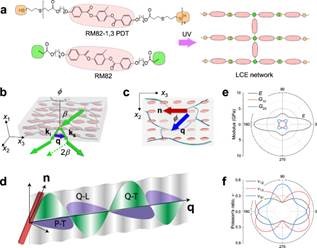Recently, Assistant Professor CANG Yu of the School of Aerospace Engineering and Applied Mechanics published a paper entitled “On the origin of elasticity and heat conduction anisotropy of liquid crystal elastomers at gigahertz frequencies” in Nature Communications (2022, 13, 524) jointly with Professor SHU Yang of the University of Pennsylvania in the United States, and Professor George Fytas of Max Planck Institute of Polymers in Germany. This research explored the high-frequency mechanics, and heat transfer anisotropy of liquid crystal elastomer revealed the anisotropy characteristics of different scales of liquid crystal elastomer, and provided insights for its on-demand programming design and high-frequency application.
Liquid crystal elastomer (LCE) has become one of the research hotspots in the application of soft robots, artificial muscle, and flexible actuators because of its excellent programmable and fast reversible driving features. These features come from the coupling of its anisotropic liquid crystal molecule (LC) and elastic cross-linking network. Identifying the relationship between LCE mechanics, heat transfer anisotropy, and microstructure is the key to realizing its controllable programming. Most of the existing research focuses on the exploration of LCE physical features at low frequencies. However, emerging high-frequency applications, such as 5G communication and RF system packaging, require LCE high-frequency physical features. To solve this problem, CANG Yu and his collaborators obtained the anisotropy of elastic modulus at the gigahertz frequency of LCE with Brillouin spectroscopy and obtained its heat transfer anisotropy through temperature wave analysis. Among them, the anisotropy of elastic modulus is different at high frequency or low frequency, which reflects the difference between local mesocrystalline orientation and network chain orientation. By characterizing the strain dependence of elastic modulus, it is found that the mechanical Fréedericksz transformation of LC is different from the soft elasticity of most LCEs, and its thermal conductivity anisotropy is affected by the combination of LC orientation and network structure.

Elastic wave propagation in liquid crystal elastomer
CANG Yu is the first author of this article, Tongji University is the first organization, SHU Yang and George Fytas are the corresponding authors, and other authors include Professor Junko Morikawa of Tokyo University of Technology. The research was supported by the Pujiang Talent Scheme of Shanghai Municipal Science and Technology Commission and the Youth Program of the National Natural Science Foundation of China.